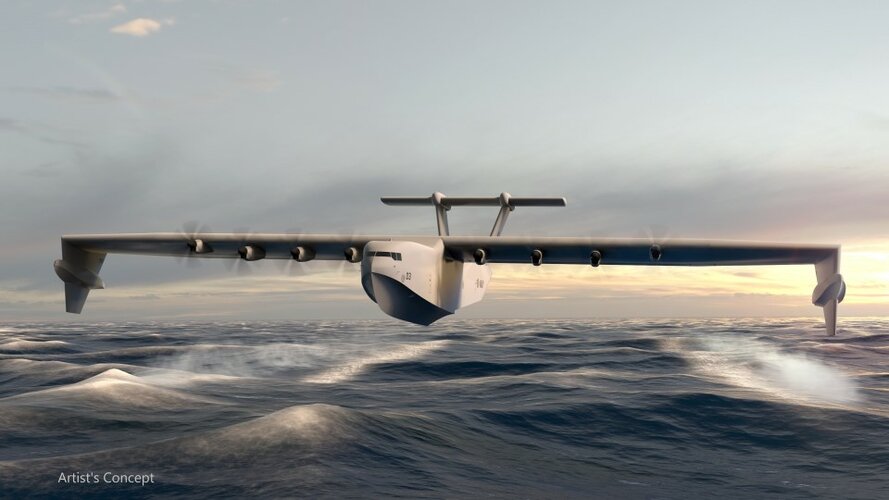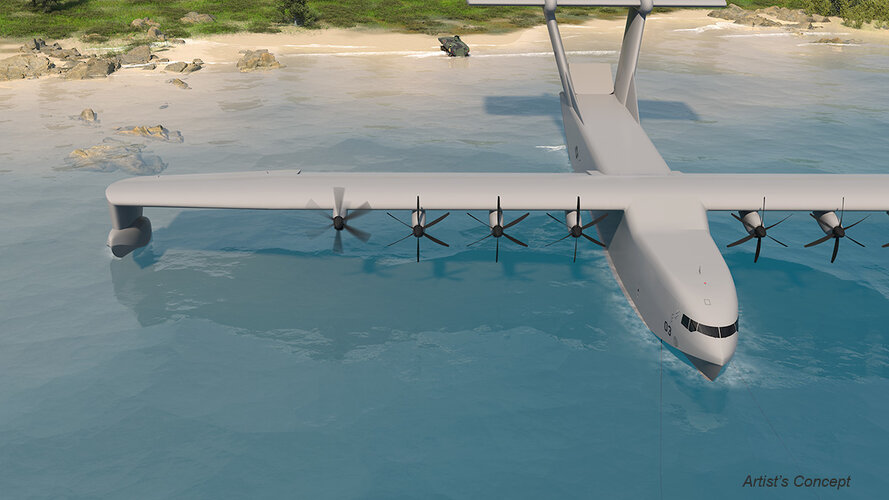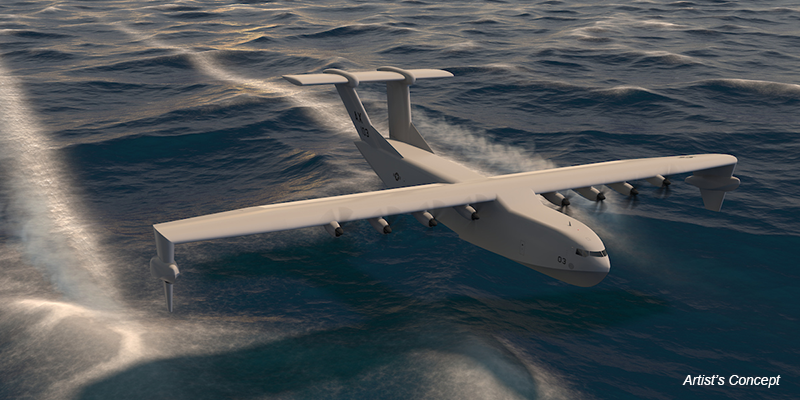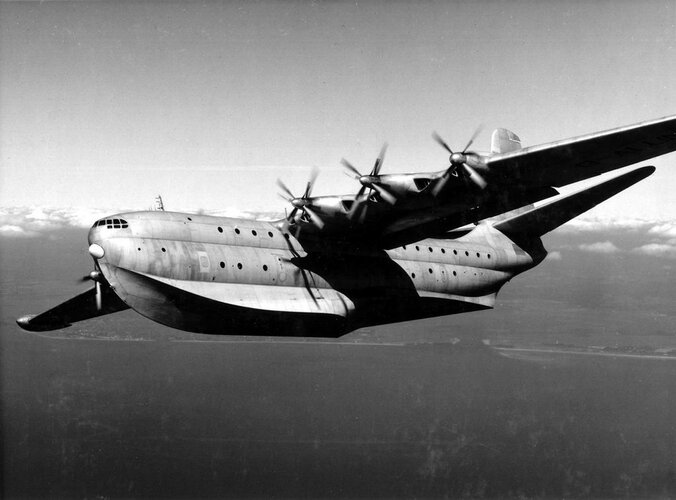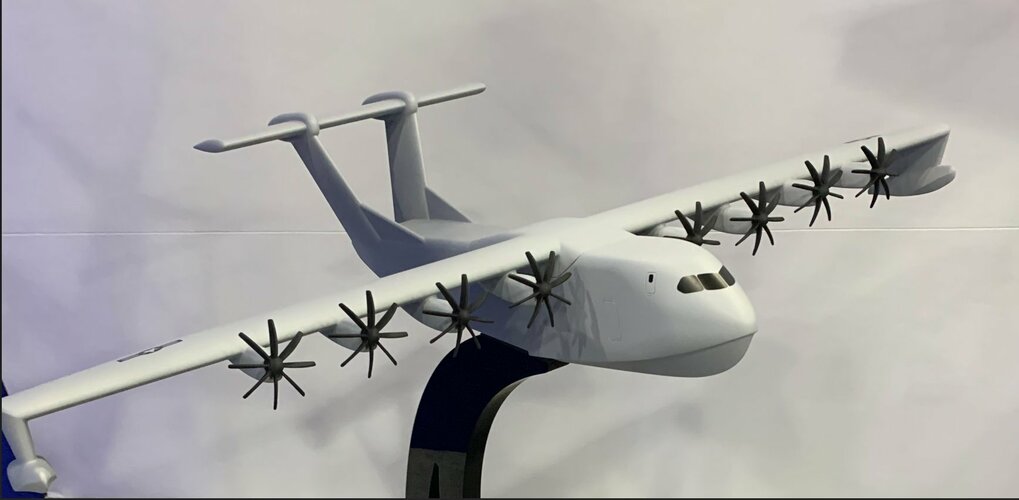
You are using an out of date browser. It may not display this or other websites correctly.
You should upgrade or use an alternative browser.
You should upgrade or use an alternative browser.
DARPA / Aurora Flight Sciences / GA-ASI Liberty Lifter WIG
- Thread starter Lc89
- Start date
- Joined
- 2 August 2006
- Messages
- 3,206
- Reaction score
- 1,320
However, if you read the specs, it's more likely to resemble a typical "flying boat" design, due to being required to fly over weather. However, it will need systems so that it can cruise in ground effect when not requiring to clear objects and weather. It isn't going to look anything like an Ekranoplane based on the requirements atm.
- Joined
- 4 July 2010
- Messages
- 2,400
- Reaction score
- 2,719
Sounds like Pelican
However, if you read the specs, it's more likely to resemble a typical "flying boat" design, due to being required to fly over weather. However, it will need systems so that it can cruise in ground effect when not requiring to clear objects and weather. It isn't going to look anything like an Ekranoplane based on the requirements atm.
Rhinocrates
ACCESS: Top Secret
- Joined
- 26 September 2006
- Messages
- 2,608
- Reaction score
- 6,191
I notice that 'long duration arctic patrol flights' appears on the list - despite warming, large expanses of sea ice will still exist and they'll be fine for a WiG. 'Arctic' is probably going to be obligatory in every specification for anything from now on anyway.
However, if you read the specs, it's more likely to resemble a typical "flying boat" design, due to being required to fly over weather. However, it will need systems so that it can cruise in ground effect when not requiring to clear objects and weather. It isn't going to look anything like an Ekranoplane based on the requirements atm.
X-39
To post or not to post, that is the question
- Joined
- 20 February 2021
- Messages
- 382
- Reaction score
- 913
Video: DARPA details its Liberty Lifter seaplane concept
By Defense Brief Editorial
-May 18, 2022

DARPA illustration of the Liberty Lifter seaplane
The US Defense Advanced Research Projects Agency (DARPA) revealed that its project to develop an ekranoplan-inspired seaplane concept would be named Liberty Lifter.
The name was announced after the agency released a request for information (RFI) in August last year, seeking ideas that could demonstrate a leap in operational logistics capabilities by designing, building, and flying a long-range, low-cost X-plane capable of seaborne strategic and tactical lift.
Leveraging the wing-in-ground effect, DARPA’s project will be similar to the ekranoplan concept that was embraced by the Soviet and Russian navies in the 1980s and 90s.
The envisioned plane will combine fast and flexible strategic lift of very large, heavy loads with the ability to take off/land in water. Its structure will enable both highly controlled flight close to turbulent water surfaces and sustained flight at mid-altitudes. In addition, the plane will be built with a low-cost design and construction philosophy.
Although current sealift is very efficient in transporting large amounts of payload, it is vulnerable to threats, requires functional ports, and results in long transit times. Traditional airlift is much faster, but has limited ability to support maritime operations. Additionally, today, such aircraft suffer payload limitations or require long runways.
There is a history of attempting to develop aircraft created to fly with “wing-in-ground effect,” which means the aircraft is flying no more than the length of its wingspan above ground or water. The most well-known examples are the Soviet “ekranoplans.” These vehicles were high speed and runway- independent, but were restricted to calm waters and had limited maneuverability.
“This first phase of the Liberty Lifter program will define the unique seaplane’s range, payloads, and other parameters,” said Alexander Walan, a program manager in DARPA’s Tactical Technology Office. “Innovative advances envisioned by this new DARPA program will showcase an X-plane demonstrator that offers warfighters new capabilities during extended maritime operations.”
To address the shortcomings of existing vehicles and operational concepts, the Liberty Lifter program focuses on addressing three main challenges.
The first one is extended maritime operations, which will place emphasis on operating in turbulent sea states by creating high-lift abilities at low speeds to reduce wave impact load during takeoff/landing, and innovative design solutions to absorb wave forces. In addition, the project will address risks of vehicle collision during high-speed operation in congested environments. Finally, the aim is for the vehicle to operate at sea for weeks at a time without land-based maintenance activities.
The second challenge will be full-scale affordable production, with the aim of prioritizing low-cost, easy-to-fabricate designs over exquisite, low-weight concepts. Materials should be more affordable than those in traditional aircraft manufacturing and available to be purchased in large quantities.
The final challenge will be the development of advanced sensors and control schemes to avoid large waves and to handle aero/hydro-dynamic interactions during takeoff/landing.
In the RFI from August 2021, DARPA also said the plane should have a large operational payload (over 100 tons) and the capability of carrying multiple amphibious vehicles.

Video: DARPA details its Liberty Lifter seaplane concept
DARPA is turning to the wing-in-ground effect concept to improve seaborne strategic and tactical lift capability.
 defbrief.com
defbrief.com
Not what i had in mind, but interesting nonetheless.
Normally when i think of DARPA, I think something along the lines of "near-magical sci-fi technologies." Now I'll have to think of "1990's-level half-assed CGI."
Last edited by a moderator:
gabrielorosco
I really should change my personal text
- Joined
- 10 December 2016
- Messages
- 177
- Reaction score
- 203
The concept is interesting, but it is very unlikely that such vehicle can operate in open sea, dealing with storms. It is also in the opposite direction of modern WIG design.
Last edited by a moderator:
- Joined
- 26 May 2006
- Messages
- 33,545
- Reaction score
- 13,647
Normally when i think of DARPA, I think something along the lines of "near-magical sci-fi technologies." Now I'll have to think of "1990's-level half-assed CGI."
I felt that at first sight.
- Joined
- 4 May 2008
- Messages
- 2,439
- Reaction score
- 735
If you read "Soviet and Russian Ekranoplans" by Kommisarov and Gordon, or the "Wingship Report" (on dtic) you will see that Ekranoplans have never operated in open ocean environments, and never flown above ~100m. This limitation is inherent in the "classic" Ekranoplan formula (low Aspect ratio stubby wing). In the Pacific you need to handle Sea state five to operate 85% of the time. Hence something that looks more like a seaplane, specifically a large version of the late Convair and Martin open ocean seaplanes. STOL performance and deeply sculpted hulls with lots of deadrise, like a ShinMaywa US-2 on steroids.
Turns out price is a technology and I wouldn't sleep on the boundary layer control either.
Normally when i think of DARPA, I think something along the lines of "near-magical sci-fi technologies." Now I'll have to think of "1990's-level half-assed CGI."
- Joined
- 21 April 2009
- Messages
- 13,562
- Reaction score
- 7,187

DARPA taps General Atomics for low-flying seaplane Liberty Lifter concept - Breaking Defense
The Liberty Lifter program aims to change how the Pentagon tackles air and sealift through a well-known, but difficult-to-use physics trick.
aonestudio
I really should change my personal text
- Joined
- 11 March 2018
- Messages
- 2,865
- Reaction score
- 7,051

GA-ASI Selected by DARPA to Support Liberty Lifter Program
General Atomics Aeronautical Systems (GA-ASI) was awarded a contract from the Defense Advanced Research Projects Agency (DARPA) for the development of an aircraft capable of sustained seaborne strategic and tactical lift.
www.ga-asi.com
The planned Liberty Lifter demonstrator will be a large flying boat similar in size and capacity to the C-17 Globemaster III transport aircraft. Goals include takeoff and land in Sea State 4, sustained on-water operation up to Sea State 5, and extended flight close to the water in ground effect with the capability to fly out of ground effect at altitudes up to 10,000 feet above sea level.
During Phase 1, DARPA will work with both performer teams and Department of Defense stakeholders to refine the Liberty Lifter designs with particular attention to operational needs and operating concepts. The Phase 1 contract awards are for an 18-month period of performance with six months of conceptual design work and nine months of design maturation culminating in a preliminary design review. There will be an additional three months for manufacturing planning and test/demonstration planning reviews.
As scheduled, Phase 1 will transition into Phase 2 in mid-2024 with continued detailed design, manufacturing, and demonstration of a full-scale Liberty Lifter X-Plane. DARPA anticipates teaming with one or more DoD Service and international partners for those activities and further development of the Liberty Lifter concept into an operational vehicle.
The General Atomics team has selected a twin-hull, mid-wing design to optimize on-water stability and seakeeping. It employs distributed propulsion using twelve turboshaft engines.
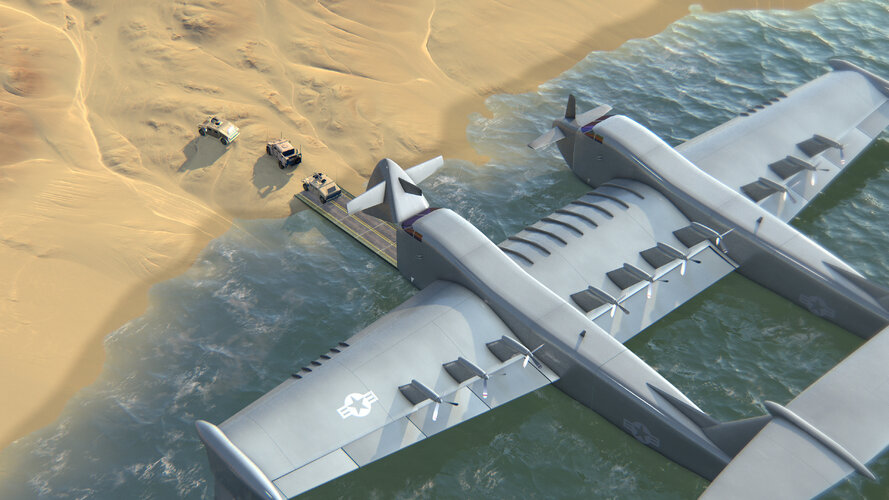
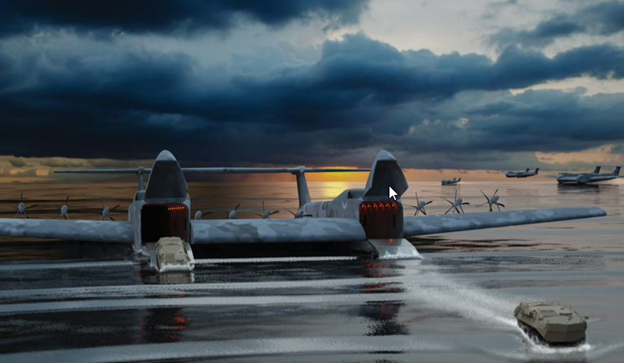
Aurora Flight Sciences point-of-departure design more closely resembles a traditional flying boat, with a single hull, high wing and eight turboprops for primary propulsion.
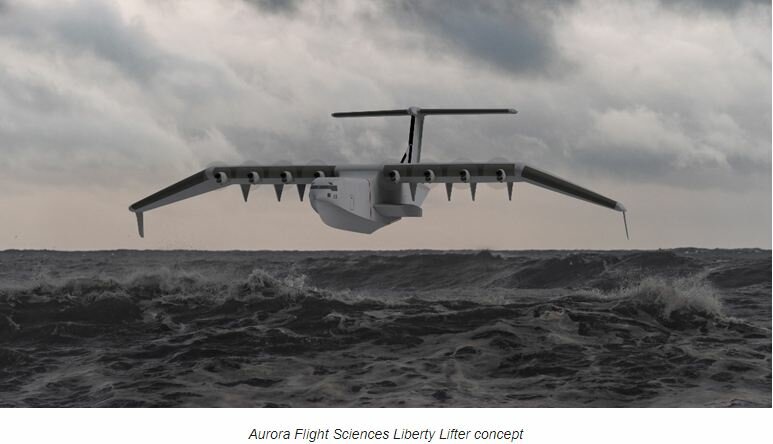
Last edited:
- Joined
- 18 October 2006
- Messages
- 4,090
- Reaction score
- 4,489
Howard Hughes would be proud!
GA-ASI Selected by DARPA to Support Liberty Lifter Program
General Atomics Aeronautical Systems (GA-ASI) was awarded a contract from the Defense Advanced Research Projects Agency (DARPA) for the development of an aircraft capable of sustained seaborne strategic and tactical lift.www.ga-asi.comThe planned Liberty Lifter demonstrator will be a large flying boat similar in size and capacity to the C-17 Globemaster III transport aircraft. Goals include takeoff and land in Sea State 4, sustained on-water operation up to Sea State 5, and extended flight close to the water in ground effect with the capability to fly out of ground effect at altitudes up to 10,000 feet above sea level.
During Phase 1, DARPA will work with both performer teams and Department of Defense stakeholders to refine the Liberty Lifter designs with particular attention to operational needs and operating concepts. The Phase 1 contract awards are for an 18-month period of performance with six months of conceptual design work and nine months of design maturation culminating in a preliminary design review. There will be an additional three months for manufacturing planning and test/demonstration planning reviews.
As scheduled, Phase 1 will transition into Phase 2 in mid-2024 with continued detailed design, manufacturing, and demonstration of a full-scale Liberty Lifter X-Plane. DARPA anticipates teaming with one or more DoD Service and international partners for those activities and further development of the Liberty Lifter concept into an operational vehicle.
Aurora Flight Sciences point-of-departure design more closely resembles a traditional flying boat, with a single hull, high wing and eight turboprops for primary propulsion.
View attachment 692456
- Joined
- 4 July 2010
- Messages
- 2,400
- Reaction score
- 2,719
TWZ piece on this award:

 www.thedrive.com
www.thedrive.com
The GA plane is going to get most of the attention forever, but Aurora's plane intrigues me.

Huge Ekranoplan-Like Airlifter Design Teams Selected By DARPA
Aurora Flight Sciences and General Atomics have been chosen to compete to design and possibly build the gigantic Liberty Lifter X-plane.
The GA plane is going to get most of the attention forever, but Aurora's plane intrigues me.
X-39
To post or not to post, that is the question
- Joined
- 20 February 2021
- Messages
- 382
- Reaction score
- 913

DARPA advances ‘Liberty Lifter’ seaplane competitors with another $40m in funding
The Pentagon's secretive technology development arm has allocated an additional $40 million to fund continued work on a heavy-lift seaplane demonstrator competition involving General Atomics and Aurora Flight Sciences.
General Atomics-Aeronautical Systems and Aurora Flight Sciences on 27 July each received contracts valued around $20 million to fund continued development efforts for the Liberty Lifter – a wing-in-ground-effect seaplane meant to carry loads of 90,000kg (200,000lb) or greater.
The 27 July contract announcement significantly raised DARPA’s commitment to the Liberty Lifter project, as the agency exercised options on both companies’ initial proposals. General Atomics will receive $21.5 million to fund additional work, while Aurora’s additional share is $19.5 million.
DARPA hopes to begin the next phase of the programme in mid-2024, which will include detailed design, manufacturing and flight demonstration of full-scale Liberty Lifter craft.
martinbayer
ACCESS: Top Secret
- Joined
- 6 January 2009
- Messages
- 2,899
- Reaction score
- 2,991
Looks just like a dual fuselage iteration of the original Boeing Pelican concept, see https://en.wikipedia.org/wiki/Boeing_Pelican, to me.
Last edited:
New renderings:

 www.aurora.aero
www.aurora.aero

Aurora’s Liberty Lifter X-Plane Progresses Through Preliminary Testing - Aurora Flight Sciences
Aurora Flight Sciences, a Boeing Company, has been selected for phase 1 of the Defense Advanced Research Projects Agency (DARPA) SPeed and Runway INdependent Technologies (SPRINT) X-Plane Demonstration Project.
Attachments
- Joined
- 17 October 2006
- Messages
- 2,354
- Reaction score
- 988
The twin-hull monster has been whacked.

 www.defensenews.com
www.defensenews.com
Which is amusing, since that design - originating with a small watercraft company who knew James Poop about airplanes - was what got DARPA started on LibertyLifter. It had two things wrong with it. It was a nasty ekranoplan design with all manner of things wrong with it, and the user requirement called for a large seaplane. Note the way that Pelican features have vanished from the Aurora design...
DARPA at the bleeding edge once again. Muppets.

DARPA taps Aurora to keep designing heavy cargo seaplane in $8.3M deal
DARPA passed on General Atomics’ dual-hulled design for Liberty Lifter, and said the company was not meeting its “aggressive” schedule and technical goals.
Which is amusing, since that design - originating with a small watercraft company who knew James Poop about airplanes - was what got DARPA started on LibertyLifter. It had two things wrong with it. It was a nasty ekranoplan design with all manner of things wrong with it, and the user requirement called for a large seaplane. Note the way that Pelican features have vanished from the Aurora design...
DARPA at the bleeding edge once again. Muppets.
Attachments
- Joined
- 18 October 2006
- Messages
- 4,090
- Reaction score
- 4,489
Why go for a 69 Jeep Wagoneer, when you can get a shiny new touring bus!Now we know why SOCOM ditched the C-130 floatplane idea.
Attachments
- Joined
- 4 July 2010
- Messages
- 2,400
- Reaction score
- 2,719
Seems to get more logical with each update. Sensible instead of sexy, here's hoping.
Scott Kenny
ACCESS: Above Top Secret
- Joined
- 15 May 2023
- Messages
- 8,758
- Reaction score
- 9,618
When the Hughes H4 and an Orlyonok love each other very much...
Similar threads
-
-
US Navy's Tactical Resupply Unmanned Aircraft System (TRUAS)
- Started by VTOLicious
- Replies: 2
-
-
-
DARPA Control of Revolutionary Aircraft with Novel Effectors (CRANE) - Aurora Flight Sciences X-65A
- Started by TomcatViP
- Replies: 49


